Girolamo Parabosco
"The rest of us are worth nothing. Who composes music? Parabosco. Who writes poetry? Parabosco. Who sings, who has a thousand talents? Parabosco. Pazienza!"[8]
So raves Parabosco's fictive rival Claudio Veggio in Doni's Dialogo della musica after the interlocutors have just sung three of Parabosco's pieces and then gone on to hear him recite some of his sonnets. At the time Doni wrote the Dialogo, the young Piacentine was only about twenty. He had learned keyboard from his father, organist at the cathedral of Brescia from 1536, before going to Venice to study composition with Willaert. Around the time he arrived in Venice a ricercar of his was published in Willaert's instrumental Musica nova of 1540, four years before the Dialogo appeared, and shortly thereafter he published his first madrigal, the three-voice Ben madonna a che siamo, in Constanzo Festa's Primo libro de madrigali a tre voci . . . novamente ristampati of 1541.[9] Yet Ben madonna is no new-styled setting but a diminutive madrigal on a text rhymed aABccDD that Parabosco rendered with almost childlike naïveté, outfitting it in a quasi-frottolistic dress suited to its simple complaint. In keeping with Festa's settings a 3, Parabosco's is largely homophonic, its voices pulling apart only occasionally in imitative or staggered entrances before moving into simultaneous, or near-simultaneous, cadences to end each verse. In this sense his reading is resolutely prosodic, matching single melodic phrases to each poetic line with little concern for syntax and even breaking syllables in midword in the way of light and parodistic genres ("ch'io mo-, ch'io mora").[10]
Parabosco may well have been the only one of Willaert's three main disciples who had already arrived in Venice by the late thirties to the early forties when Strozzi and Capponi were both encamped there, and who had begun by practicing a decidedly pre-Musica nova art. This may help explain why so much variety is found among his juvenilia from 1544, four in Doni's Dialogo della musica and one in Rore's Secondo libro de madrigali a cinque voci. Of these, two set poems by Petrarch (the octave from the sonnet Giunto m'ha Amor fra belle e crude braccia, no. 171, and stanza seven from the sestina Nessun visse giamai più di me lieto, no. 332); one the octave from a sonnet by the Florentine Lodovico Martelli (Pur converrà ch'i miei martiri amore );[11]
[8] "Noi altri ci siam per nulla; chi compone i canti, Parabosco; chi fa versi, Parabosco; chi suona, chi ha mille virtù, Parabosco. Pazienza" (Antonfrancesco Doni, Dialogo della musica, ed. G. Francesco Malipiero and Virginio Fagotto [Vienna, 1965], p. 190). Another edition of the Dialogo is that of Anna Maria Monterosso Vacchelli, L'opera musicale di Antonfrancesco Doni, Instituta e monumenta, ser. 2, no. 1 (Cremona, 1969).
[9] The latter work may have appeared even earlier since the Festa print is called "ristampato" on Gardane's title page, but the original edition is now lost (see Fenlon and Haar, The Italian Madrigal, p. 231). A mod. ed. of Ben madonna is included in Gerolamo Parabosco, Composizioni a due, tre, quattro, cinque e sei voci, ed. Francesco Bussi (Piacenza, 1961), pp. 5-6. For the ricercar see Musica nova accommodata per cantar et sonar sopra organi, ricercar "Da pacem," pp. 123-24. For further on Parabosco's biography see the citations in Chap. 1 n. 38 above.
[10] For Zarlino's proscription against this see Le istitutioni harmoniche (Venice, 1558), p. 341.
[11] For the Petrarch settings see the eds. in Doni, Dialogo della musica, pp. 64-69 and 123-28, respectively. For Pur converrà see idem, pp. 58-63, and Parabosco, Composizioni, pp. 7-11; for the poem see Lodovico Martelli, Rime volgari (Rome, 1533), fols. 20-20'.
one set a ballata by the Venetian Giovanni Brevio (Cantai mentre ch'io arsi del mio foco );[12] and the fifth — the one that appeared in Rore's collection — set a gloss on Petrarch's sonnet Anima bella da quel nodo sciolta.[13] These texts anticipate the predilection Parabosco, or his patrons, had for established poets. In his only printed madrigal collection, Madrigali a cinque voci of 1546, every poet can be named, save one, a distinction not shared by any of the other collections by Willaert's students (see Table 9). By 1544, in keeping with this high literary tone, Parabosco's madrigals also began to fashion themselves in response to Willaertian declamatory ideals: largely syllabic, carefully accentuated, complexly textured, ingeniously articulated, expressively colored, and newly sensitive to the subtleties of rhetoric.
Nevertheless, in altering or abridging a number of the texts he set, Parabosco eschewed the absolutist demands for perfect literary integrity that Willaert and Rore were making in the 1540s. His Anima bella irreverently tacks a newly written quatrain onto a quatrain by Petrarch. Another setting, Niuna sconsolata (in the Madrigali a 5 ), begins a thirteen-line madrigal by quoting the three-line ripresa from Boccaccio's ballata of the same incipit.[14] Such texts move between standard ploys of imitation and something more like revision. In line with the radical manipulations they work on preexistent verse, Parabosco's other settings often truncate poems, in some cases drastically. At other times, they extract stanzas from canzoni and sestine or take octaves from sonnets to set either in one part (as in Giunto m'ha Amor ) or in two (as in I' vo piangendo from the Madrigali a 5 ). Truncations of extended lyrics were of course a typical corollary of the fairly freewheeling attitudes madrigalists across Italy often held about the texts they set, and it was precisely those attitudes that were called into question by the new reverence with which Venetians began treating vernacular poetry. Perhaps it is no surprise that a poet and brash, self-made man of culture like Parabosco would not fully have shared them.
Parabosco's music written for 1544 collections shows less sweeping affinities with Willaert's practice than that from 1546. The truncated Giunto m'ha Amor set a 4 forms a case in point and a revealing basis for comparison with Parabosco's later work. Giunto m'ha Amor does not model itself on Willaert's five-voice setting from the Musica nova but unfolds in a series of Willaertian expositions on overlapping syntactic units.[15] Unlike Willaert, Parabosco balanced the claims of syntax against those of versification, rather than calibrating cadences strictly according to words' grammatical weight and order. The differences are notable in Willaert's and Parabosco's settings of vv. 2-3 of Giunto m'ha Amor, both of which are marked by
[12] Modern eds. in Parabosco, Composizioni, pp. 12-24, and Doni, Dialogo della musica, pp. 176-88; for the poetic source see Table 6, no. 1.
[13] Modern ed. in Einstein, The Italian Madrigal 3:151-54.
[14] Cf. Boccaccio, Decamerone, ed. Mario Marti, 5th ed., 2 vols. (Milan, 1984), 1:262, and Girolamo Parabosco, Il primo libro dei madrigali, 1551, ed. Nicola Longo (Rome, 1987), p. 113.
[15] Neither does Parabosco's setting show any relationship to Girolamo Scotto's setting of 1542, whose declamation is often oblivious to textual accent; see Madrigali a quatro voci di Geronimo Scotto con alcuni alla misura breve, et altri a voce pari . . . Libro primo (Venice, 1542), no. 20.
strong articulation owing to the deployment of three grammatical clauses over four poetic lines (as marked below in the version from Willaert's setting).
[1] Giunto m'ha Amor fra belle e crude braccia, [1] Love has brought me within reach of lovely, cruel arms
Che m'ancidono à torto, [2] e s'io mi doglio That unjustly kill me, [2] and if I complain
Doppia 'l martir, [3] onde pur, com'io soglio, he redoubles my torment; [3] thus still, as I am wont,
Il meglio è ch'io mi mora amando e taccia. it is better that I die loving and be silent.
In Petrarch's text all three syntactic parcels are effectively displaced from the versification, the first ending in the middle of v. 2 and the second in the middle of v. 3. For Willaert, these clauses determined the shape and layout of the syntactic counterpoint, as seen in the articulations he makes in the middles of those verses (See Ex. 33a beginning with v. 2). "E s'io mi doglio" and "onde pur" generate new soggetti (albeit internally varied ones) and, for the most part, new pitch planes. Willaert's setting separates each clause with rests, projecting the enjambments and practically effacing the poetic prosody. By contrast, Parabosco's setting virtually inverts Willaert's hierarchy of syntax and versification, closing off "Che m'ancidono a torto" with a simple cadence that is weak by comparison with the four-voice diminished clausula in mi ending "e s'io mi doglio" (Ex. 33b; compare mm. 8 and 10) and unfolding a separate exposition on "Dopp'il martir." Parabosco's ostensibly syntactic treatment thus masks what is really a poetic one, while Willaert treats the text almost as though it were prose.[16]
Put another way, Parabosco parsed text more like song than prose-based polyphony, consistent with his more lyric declamation. Not only are his melodies prone to free melismatic flights reminiscent of Rore's (see, for instance, the melisma in the tenor on "soglio," Ex. 33b, mm. 15-18), they are also more extended than Willaert would allow. Willaert, for example, set the r-, o-, and consonant-laden "e rompr'ogn'aspro scoglio" with unvaried austerity, reiterating a series of quarter notes (Ex. 34a), while Parabosco broke up the line to lyricize at least one voice (again, the tenor) with florid turns, graceful dotted notes, and leaps (Ex. 34b). In this sense Parabosco's Giunto m'ha Amor, and other settings of his from 1544, indicate he was under the sway of Rore's First Book. Given Veggio's suggestion that Parabosco was a fairly proficient singer — Veggio mentions it in a world in which virtually everyone could sing — and given his acquaintance with Ruberto Strozzi and the whole circle of those close to Willaert and Capponi, we can guess that Parabosco knew Rore's madrigals from having sung them in salons himself. Two of his madrigals can be located specifically within Rore's madrigalian production: Anima bella, the Petrarchan adaptation that had its debut in Rore's Second Book,
[16] For further on Willaert's setting, see Howard Mayer Brown, "Words and Music: Willaert, the Chanson and the Madrigal about 1540," in Florence and Venice, Comparisons and Relations: Acts of Two Conferences at Villa I Tatti in 1976-1977, vol. 2, Il Cinquecento, ed. Christine Smith with Salvatore 1. Camporeale (Florence, 1980), pp. 225-28.
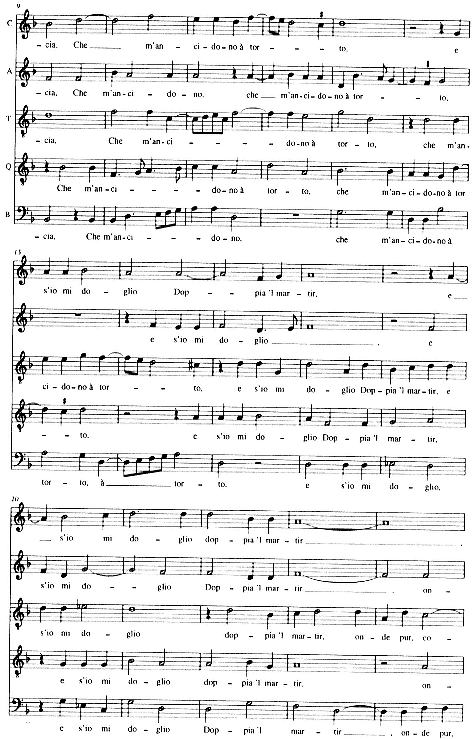
Ex. 33A.
Willaert, Giunto m'ha Amor fra belle e crude braccia (Petrarch, no. 171),
mm. 9-24; Musica nova (Venice, 1559), no. 11.

Ex. 33B.
Parabosco, Giunto m'ha Amor fra belle e crude braccia (Petrarch, no. 171),
mm. 5-18; in Antonfrancesco Doni, Dialogo della musica (Venice, 1544), fol. 14
in cantus.
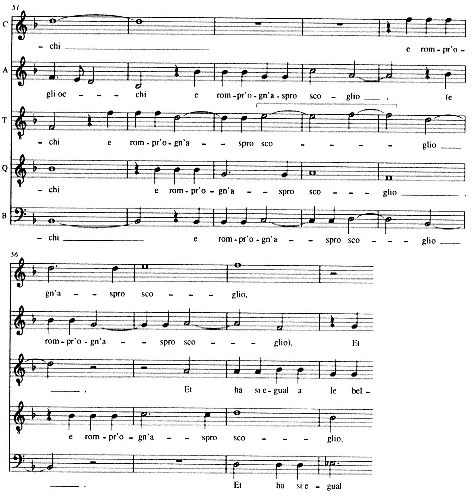
Ex. 34A.
Willaert, Giunto m'ha Amor fra belle e crude braccia (Petrarch, no. 171),
mm. 51-59; Musica nova (Venice, 1559), no. 11.
and the six-voice setting of Brevio's Cantai mentre ch'io arsi. The latter shows extensive similarities with the setting Rore had published at the head of his First Book, from the same signature and final (G mollis) and overall length (104 breves compared with Rore's 105) to numerous details of interpretation.
Cantai mentre ch'io arsi is a ballata, organized sonnetlike in fourteen hendecasyllabic verses, whose grammatical articulation coincides exactly with its formal scheme.[17]
[17] I give the poem as it appears in Parabosco's setting. Bussi mistakes the poem for a sonnet and therefore presents a wayward analysis of Parabosco's setting (Umanità e arte di Gerolamo Parabosco: madrigalista, organista, e poligrafo [Piacenza, 1961], p. 127). The form of Brevio's ballata is exactly the same as that of Petrarch's ballata no. 63, "Volgendo gli occhi al mio novo colore": a four-line ripresa (ABBA), a pair of three-line mutazioni (CDE/DCE), and a four-line volta (EFFA), all in endecasillabi.
For Parabosco's complete setting, see the eds. cited in n. 12 above and for Rore's setting see his Opera omnia, ed. Bernhard Meier, Corpus mensurabilis musicae, no. 14, AIM, vol. 2 ([Rome], 1963), pp. 1-4.
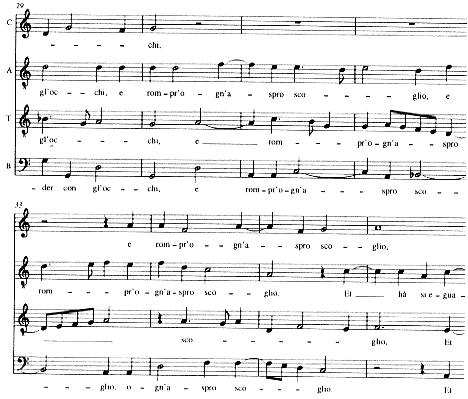
Ex. 34B.
Parabosco, Giunto m'ha Amor fra belle e crude braccia (Petrarch, no. 171),
mm. 29-36; in Antonfrancesco Doni, Dialogo della musica (Venice, 1544), fol. 14
in cantus.
Cantai, mentre ch'io arsi, del mio foco I sang while I burned from the living flame
La viva fiamma, ov'io morendo vissi, Of my fire, whence I dying lived,
Benchè quant'io cantai e quant'io scrissi Although what I sang of and what I wrote
Di madonna e d'amor, fu nulla o poco. About my lady and love were nothing, or little. 4
Ma se i begli occhi ond'il mio cor s'accese But if the lovely eyes from which my heart burned
Del lor chiaro divin almo splendore Had not wrongly found me unworthy
Non m'havessero a torto fatto indegno, Of their bright, divine, life-giving splendor,
Col canto havrei l'interno e grave ardore With a song I would have made known
Agl'orecchie di tal fatto palese, My grave inner passion to those ears,
Che pietà fora ove alberga ira e So that there might be pity where anger and disdain
sdegno. now dwell. 10
Agl'amorosi strali fermo segno I would be a sure mark for the
Sarei, pieno di dolce aspro martiro, Amorous darts, full of bittersweet grief,
Ov'hora in libertà piango e sospiro: Where now in freedom I weep and sigh:
Ahi, pace in cor d'amanti non ha loco. Oh, peace has no place in the hearts of lovers! 14
The ripresa (vv. 1-4) encloses the ballata's life-death conceit in a single extended period, then elaborated in a complex if-then qualifier by the mutazioni (vv. 5-10). The mutazioni thereby culminate in the kind of rhetorical resolution usually reserved in a sonnet for the final verse, but typical at this point in a ballata. In the third and last clause the volta (vv. 11-14) provides by comparison more modest thematic closure through a distant trope on what has gone before, while still strengthening the poem's end by reintroducing the A rhyme that frames the ripresa.
Both Rore and Parabosco avoided dividing the ballata into two parts after the ripresa but marked its chief formal divisions with strong cadences. Like most of his other settings, Rore's is extensively articulated by means of cadences at every verse ending as well as at some of the internal caesurae (vv. 2 and 3). More strongly than Parabosco's setting Rore's reinforces the structural breaks at vv. 4 and 10 with two successive cadences for each (mm. 29 and 32 and mm. 61 and 64, respectively). Parabosco's setting, by contrast, uses few cadences. The first one, a major sixth to octave on C fortified with a descending fifth in the bass, appears only at the end of the ripresa (m. 31), with a similar one on B-flat (minor third to unison, now with a rising fourth in the bass) at the end of the mutazioni (m. 72).
While paying less attention to large formal divisions, Parabosco apparently emulated some of Rore's declamatory rhythms (as at the opening). What is more, he took over voicings and intervals from a striking contrapuntal passage on "dolce aspro martiro" from v. 12 that absorbs Brevio's Petrarchan oxymoron of bittersweet grief into successions of parallel sixths (Exx. 35a and 35b).[18] Especially noteworthy in connection with Parabosco's imitation is that Rore's setting deploys parallel six-three chords first in the upper voices (mm. 75-76), later shifting them to altus and bassus in staggered declamation and writing the last two intervals as major (mm. 79-80). In so doing Rore introduced dissonance in a mild way but accentuated it with the spiky major seventh struck on "aspro" (E-flat and d, m. 80 — recall Zarlino's dicta on parallel motion and major intervals). Both passages resemble Willaert's exposition of the incipit "Aspro core e selvaggio, e cruda voglia" (Chap. 7, Ex. 16), which Parabosco himself imitated in a later setting (Ex. 38 below), as well as Rore's own apparent imitation of Willaert's exposition in setting the line "Sgombrino l'altre voglie aspr'e selvaggie" from Sfrondate, o sacre dive (Chap. 8, Ex. 32). Parabosco made similar use of parallel six-three chords in setting v. 12 from Solo e pensoso, "Ma pur sì aspre vie nè sì selvaggie," (Madrigali a 5; see Ex. 36). The entire complex of passages thus par-
[18] On Willaert's use of the six-three chord and parallel sixths as mild dissonances, see Armen Carapetyan, "The Musica Nova of Adriano Willaert: With a Reference to the Humanistic Society of 16th-Century Venice" (Ph.D. diss., Harvard University, 1945), pp. 172-73 and passim.
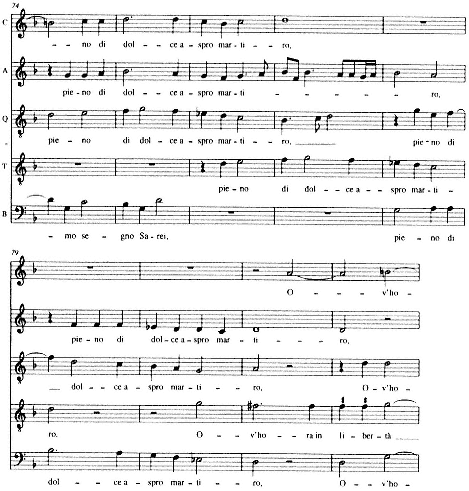
Ex. 35A.
Rore, Cantai mentre ch'i arsi del mio foco (Giovanni Brevio), mm. 74-82;
Madrigali a 5 (Venice, 1542), no. 1.
ticipates in a single musical topos that Venetian composers cultivated for expressions of harshness and wildness — a topos whose roots probably lie in Willaert's Aspro core and possibly in Rore's Cantai mentre ch'i arsi as well.[19]
The indebtedness of Parabosco's Cantai mentre ch'io arsi to Rore's setting is clearest at mm. 80-84, where it intermittently adopts Rore's parallel sixths and six-three chords when delivering "martiro" (Ex. 35b). Parabosco also adopted Rore's disposition of the text in semichoirs, high, then low (though his are more homorhythmic), and matched Rore's rhythmic declamation almost exactly (compare Rore's cantus at mm. 74-77 with Parabosco's at mm. 79-81). The only other
[19] We could also add to this group the parallel-third-filled exordium of Rore's Strane ruppi, aspri monti, alti tremanti (see Ex. 15).
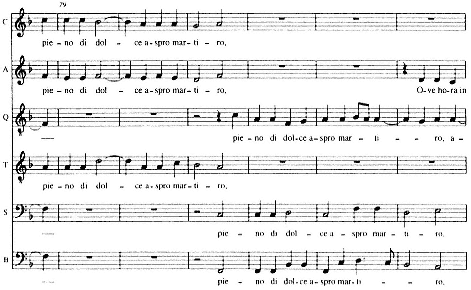
Ex. 35B.
Parabosco, Cantai mentre ch'io arsi del mio foco (Giovanni Brevio),
mm. 78-84; in Antonfrancesco Doni, Dialogo della musica (Venice, 1544),
fol. 31 in cantus.

Ex. 36.
Parabosco, Solo e pensoso, i più deserti campi
(Petrarch, no. 35), mm. 91-92; Madrigali a 5
(Venice, 1546), no. 4.
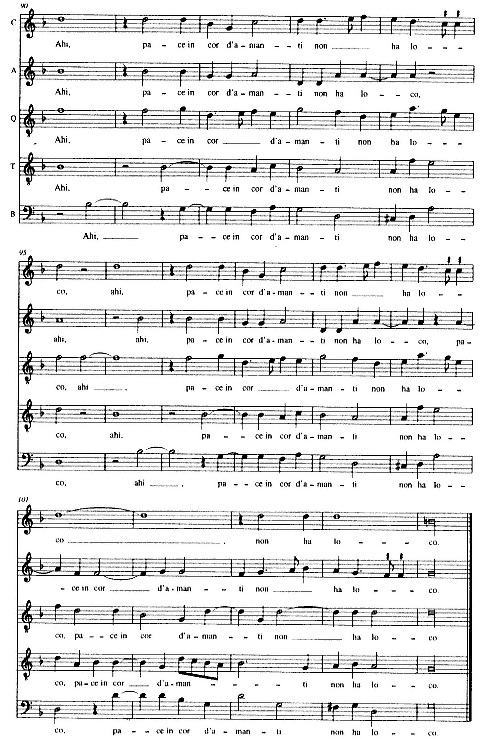
Ex. 37A.
Rore, Cantai mentre ch'i arsi del mio foco (Giovanni Brevio),
mm. 90-105; Madrigali a 5 (Venice, 1542), no. 1.
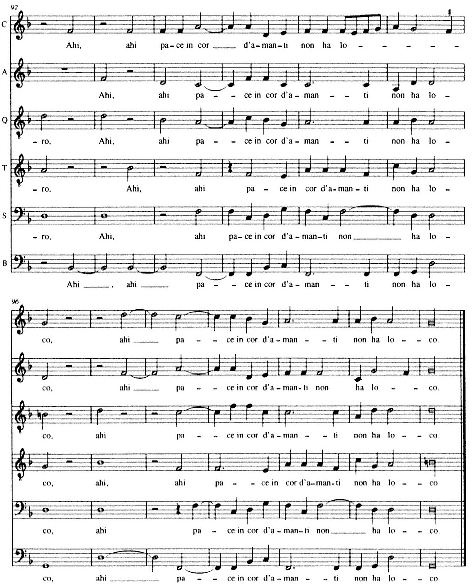
Ex. 37B.
Parabosco, Cantai mentre ch'io arsi del mio foco (Giovanni Brevio),
mm. 92-104; in Antonfrancesco Doni, Dialogo della musica (Venice, 1544),
fol. 31 in cantus.
passage that echoes Rore's so closely is the one setting the final aphorism, "Ahi, pace in cor d'amanti non ha loco" (compare Exx. 37a and 37b). Here the gasping "Ahi"s of both settings follow conventional practice, but Parabosco specifically emulated Rore in mm. 92-94 by staggering the vocal entrances in even semibreves over a B-flat in the bass.
Like Willaert's other students, Parabosco assembled his only madrigal collection, dedicated to Ruberto Strozzi, as a polyphonic miscellany.[20] All the poems in the Madrigali a 5 align themselves with a literary vernacular and most explore the amorous, metaliterary tropes of courtly Petrarchan verse. Apart from these commonalities, the book embraces a wide variety of poetic forms and registers across the whole upper range of the Ciceronian spectrum, approaching the heterogeneity of a book like Rore's second by excluding only comic, low, and dialect verse. Given the ideals of Ciceronian propriety that (I have argued) demanded this exclusion, it is no surprise that Parabosco's Madrigali a 5 bears little resemblance to his Lettere amorose, Lettere famigliari, I diporti, Il viluppo, or a host of other quasi-colloquial texts that he published between 1545 and his death in 1557. In most of these literary works Parabosco was openly eclectic, often droll, and at least a little subversive, evincing that self-serving blend of establishmentarianism and iconoclasm that defines the social climber in cosmopolitan Venice. Yet his one collection of madrigals was concertedly literary. None of Willaert's other students' books match Parabosco's in the amount of verse included that could also claim existence in literary venues. By concentrating on poems that carried enough cachet to have circulated with respectable lyric identities outside of music, Parabosco's collection could project a certain level of urbane sophistication. Perhaps to that end, the book avoids the provincial madrigalistic verse of his Piacentine countrymen Lodovico Domenichi, Bartolomeo Gottifredi, and even the wildly popular Luigi Cassola. It opens instead with two of Parabosco's own poems (a madrigal and a ballata-madrigal), then mixes in poems by more celebrated contemporaries — Baldassare Castiglione, Lodovico Martelli, Fortunio Spira, and Giovanni Mozzarello — among the many settings of Petrarch.
This chic vernacular eclecticism may explain why the book is built less on strictly high-styled, and especially "classical," sonnets than any of the other five-voice collections by Willaert's immediate pupils. Only six of its twenty numbers are complete sonnet settings (nos. 3, 4, 5, 7, 15, and 17), an additional two settings of sonnet octaves (nos. 13 and 14), as seen in Table 9. Of the nine Petrarchan settings (not counting Anima bella), only three are full sonnets, the rest partial sonnet settings (nos. 11 and 14) and stanzas drawn from canzoni (nos. 10 and 16) and sestine (nos. 9 and 12). About a third of the poems can be described as madrigals (nos. 1, 6, 8, 18, 19, and 20) or ballata-madrigals (no. 2).
[20] For the dedication see Chap. 2 n. 65 above. There is no mod. ed. of the collection at present.
| ||||||||||||||||||||||||||||||||||||||||||||||||||||||||||||||||||||||||||||||||||||||||||||||||||||||
(table continued on next page)
(table continued from previous page)
| ||||||||||||||||||||||||||||||||||||||||||||||||||||||||||||||||||||||||||||||||||||||||||
This idiosyncratic and rather paradoxical literary character — not conventionally elevated with a saturation of sonnets but nevertheless steeped in verse of recognizable pedigree — is matched by an equally unusual modal plan. Like many midcentury collections, the book is organized by cantus mollis and cantus durus as well as by final. The design that results seems to consist of four modal categories irregularly arranged without regard to ambitus: protus (nos. 1-4), tritus (nos. 5-8), deuterus (nos. 9-14), and tetrardus (nos. 15-20).[21]
Among the weightiest and surely the best-known setting in the Madrigali a 5 is Parabosco's Aspro cor. Since Helga Meier's study of 1969, it has been widely recognized that Willaert's students at San Marco emulated some of his Musica nova settings with borrowings and citations in their resettings of the same texts.[22] Given that Aspro cor is the only one of Parabosco's settings to have done so directly, it is not surprising that it took over Willaert's decorum, gravity, careful rhetorical shaping, and many of his specific readings more completely than did any of Parabosco's other settings. (We will see that Parabosco's colleagues also followed Willaert's practices most closely when actually modeling their settings on his.) Indeed, Parabosco's imitation of Willaert is arguably even more striking than Meier made out.[23] It quotes almost literally the extraordinary conception Willaert imposed on the first verse, even while replacing Willaert's G-durus eighth mode with a G-mollis transposed second (Ex. 38; cf. Ex. 16). It also adopts the descending melodic profile of the main motive and, like Willaert's, introduces the vocal groups in a three-plus-three arrangement (v. 1; v. 1 repeated — though with Parabosco's reduction to five voices, one voice sings v. 1 twice). And, most important, it borrows the six-five and four-three suspensions, the parallel major thirds mentioned by Galilei, and the concentration of major imperfect intervals that makes Willaert's setting so distinctive.
Yet Parabosco's departures from Willaert's version reveal even more than his borrowings, for on the whole he alleviated the austerity of Willaert's reading despite the harsh character of the poem. The tenor voice that begins the exposition imitates Willaert's motive, but its effect is undermined by the syncopated entrance of the alto a minim later and a new syncopation introduced in the cantus in mm. 2-3. These syncopations lighten the overall ethos of the passage while slighting considerations of textual stress and sense: the word "e" invites syncopation and prolongation in the cantus not for its accentual position or textual meaning but only to allow a more sensuous surface. Willaert's rhythms, by comparison, initially spaced a semibreve apart and wholly bound to the tactus through v. 1, help fix and maintain a more
[22] "Zur Chronologie der Musica Nova Adrian Willaerts," Analecta musicologica 12 (1973): 71-96.
[23] For a mod. ed. of the madrigal see Fünf Madrigale venezianischer Komponisten um Adrian Willaert zu 4-7 Stimmen, ed. Helga Meier, Das Chorwerk, vol. 105 (Wolfenbüttel, 1969), pp. 14-22. See also Meier's discussion of the madrigal in the preface to the edition, p. iv, and in "Zur Chronologie der Musica Nova, " p. 78. In Fünf Madrigale Meier points out how Parabosco's setting of Aspro core and Donato's setting of I vidi in terra angelici costumi and Liete e pensose made explicit references to Willaert's models by placing citations in exposed positions at the beginnings or ends of one of the parti.
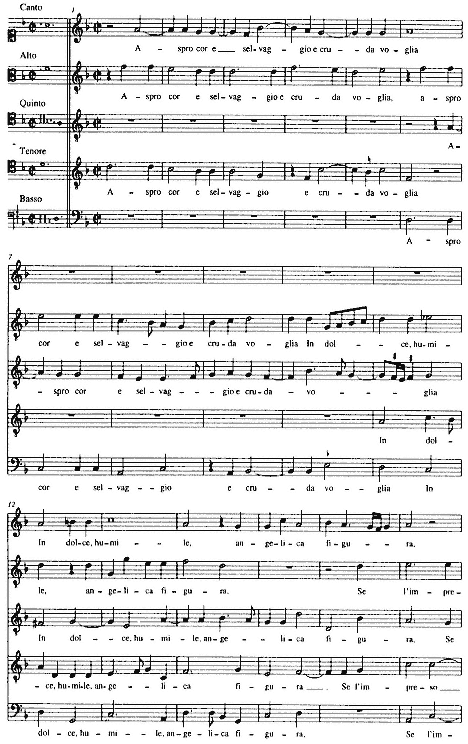
Ex. 38.
Parabosco, Aspro cor e selvaggio e cruda voglia (Petrarch, no. 265),
mm. 1-17; Madrigali a 5 (Venice, 1546), no. 3.
solemn pulse. The slow stepwise motion is hardly relieved by repeated minims, which do no more than fill in the basic semibreve structure.
In fact, Parabosco nearly reversed the role of metric stress and the discrete roles of tonic and agogic accents that Palisca found so striking a feature of Willaert's rendition, especially Willaert's staunch avoidance of syncopation in v. 1 and exploitation of it in v. 2; (see Chap. 7 n. 59). Furthermore, Parabosco's setting minimizes semantic contrasts between the verses by sprinkling the repetition of v. 1 with dotted semiminims while reducing the level of syncopation in v. 2. Despite the sdrucciolosa lilt in Petrarch's second verse, Parabosco had all the voices but the alto enter on the tactus. Similarly, he minimized the major-minor intervallic polarities that Palisca noted in Willaert's model by eliminating v. 2's emphasis on minor intervals. The only consistent way in which Parabosco realized these semantic dichotomies was through conventions that aligned textual meaning with melodic direction, moving largely downward for v. 1 and upward for v. 2.
In later passages Parabosco actually appropriated more completely Willaert's rhetorical delivery. At the beginning of v. 7, "Piango ad ogn'hor," for example, his setting exploits the same minor intervallic relationships with which Willaert's had personified the poet's weeping in the second quatrain (Exx. 39a and 39b).
Che quando nasce e mor fior erba e foglia, For when the flowers, grass, and leaves are born or die,
Quando è 'l dì chiaro e quando è notte oscura, When it is bright day and when it is dark night,
Piango ad ogni hor. Ben ò di mia ventura, I weep at all times. From fate,
Di Madonna, e d'Amor onde mi doglia. From my lady, and from Love I have much to grieve me. 8
Parabosco's setting concentrates on minor seconds and minor thirds, stressing the relationships B-flat/A and B-flat/G (cantus, tenor, quintus), as well as D/E-flat and E/F (altus). Beyond this, both settings take the beginning of v. 7 as a point of formal rupture by emphasizing the prosodic asymmetry it introduces into the quatrain. The nine and a half breves Willaert assigned to the first part of v. 7, "Piango ad ogn'hor" (as opposed to eight for all of v. 5 and seven for v. 6) magnify it rhetorically; Parabosco follows suit with eleven breves (compared with nine and eight and a half for vv. 5 and 6, respectively), and both set up its entrance with a perfect cadence and a registral shift to end v. 6 (aided in Willaert's case by a slowed surface motion).
Parabosco's setting continues to evoke the memorable textural, rhythmic, and tonal events that Willaert had deployed to mark the sonnet's major formal-expressive divisions in the sestet. But, here again, his setting mollified Willaert's effects. The voicing that opens Parabosco's seconda parte — three homophonic inner voices leading off, a fourth joining them after a semibreve, and the bass entering two and a half breves later — borrows from Willaert's, and the bass line in fifths comes from Willaert too (though Parabosco fails to sustain it beyond three chords). Parabosco
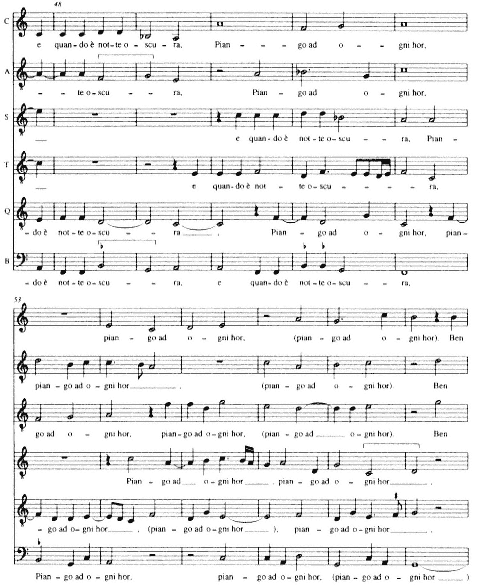
Ex. 39A.
Willaert, Aspro core e selvaggio e cruda voglia (Petrarch, no. 265),
mm. 48-58; Musica nova (Venice, 1559), no. 14.
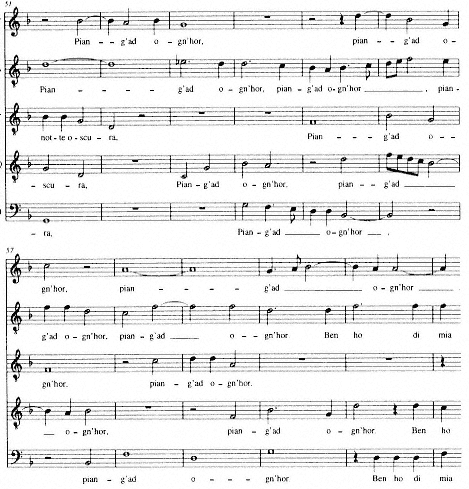
Ex. 39B.
Parabosco, Aspro cor e selvaggio e cruda voglia (Petrarch, no. 265),
mm. 51-62; Madrigali a 5 (Venice, 1546), no. 3.
used Willaert's rhetorical markers again at the beginning of the second tercet, "Non è sì duro cor che lagrimando," by isolating the first half of the verse, but here his motivic and tonal manipulations enervate the model even more (Exx. 40a and 40b). Willaert had started with a cross relation introduced by f-sharp in the sextus (third voice from the top, m. 103), which occurs within yet another brief circle-of-fifths progression, A to C, originating in the previous phrase. All but one of his approaches to "duro" hammers away in repetition figures that move up by major second. Parabosco treats the clause less uniformly, maximizing motivic and metric variety between parts where Willaert's setting pointedly avoids doing so, while underscoring Petrarch's verbal dissonance. His tenor leaps on "duro" to a mild minor sixth over the bassus (m. 105), resolving immediately to a perfect fifth. Three measures later (mm.
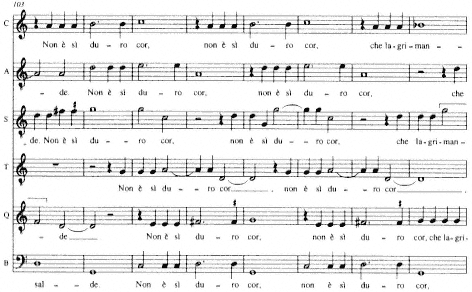
Ex. 40A.
Willaert, Aspro core e selvaggio e cruda voglia (Petrarch, no. 265),
mm. 103-10; Musica nova (Venice, 1559), no. 14.
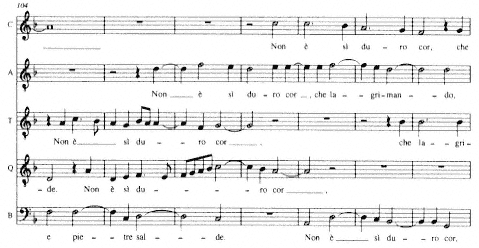
Ex. 40B.
Parabosco, Aspro cor e selvaggio e cruda voglia (Petrarch, no. 265),
mm. 104-10; Madrigali a 5 (Venice, 1546), no. 3.
108-9) suspended parallel sixths between outer voices invoke the madrigal's beginning.
Willaert's and Parabosco's treatments of the sonnet's final verse, "Ne sì freddo voler che non si scalde" (nor is there a will so cold that it cannot be warmed), resemble one another rhythmically but only confirm the sense that Parabosco largely refrained from riveting particular rhetorical effects to a single musical reading. In syncopating "freddo" with a dotted figure, Willaert's reading reinforced a level of
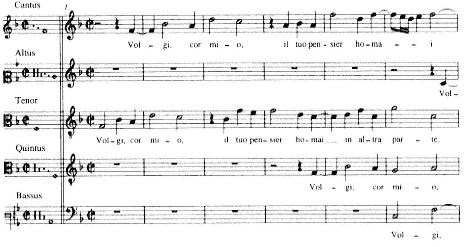
Ex. 41.
Parabosco, Volgi, cor mio, il tuo pensier homai (Fortunio Spira),
mm. 1-6; Madrigali a 5 (Venice, 1546), no. 7.
dissonance that Petrarch's poem achieves through consonantal clusters. The pompous energy of his syncopations captures rhythmically the spirit of the "cold will." By declaiming the word wholly in minims and thus misaccenting both syllables, Parabosco turned his back on Willaert's text-generated diction, giving up Willaert's semantic emphasis as well as the means to a stagier rhetorical climax.
Willaert's submission of all dimensions of his Musica nova madrigals to the rigors of a rhetorically determined declamation resulted in a speechlike musical oratory that his pupils generally pursued less adamantly than they did endearing local moments. The difference is evident even in Parabosco's sonnet settings, many of which (like Aspro cor ) are less weighty than one might expect. We should recall in this regard that in midcentury Venice a preoccupation with Petrarch did not necessarily signal elitism or even imply de facto a preference for sonnets. Petrarch after all was the most widely disseminated poet in the marketplace of printed editions and commentaries, and the sonnet by far the most common genre of the mid-sixteenth century (as abundantly evident in the copious anthologies of the time). Not all of the modern sonnets Parabosco set were especially introspective, nor were his settings of them. Mozzarello's O desir di questi occhi, for one, is an untroubled series of apostrophes to the beloved ending with a vaguely erotic "Deh, sarà mai ch'io vi riveggia et oda?" (Ah, will I ever see and hear you again?) that Parabosco set lightly in a compact ninety-four breves.[24] Similarly, his cheerful fifth-mode setting of Spira's Volgi, cor mio, il tuo pensier homai depicts a spurned poet who makes a pact with his heart over a disdainful lady; for this Parabosco opened with a cantus-tenor duet in quixotic fourths and graceful syncopations (Ex. 41).
[24] See the ed. in Bussi, Composizioni, pp. 38-50. It is not the only setting so brief; Parabosco's setting of Petrarch's Gli occhi di ch'io parlai is only eighty breves long.
Poems like these did not invite the expansively weighty style Parabosco used to set sonnets like Aspro core, Solo e pensoso, or I' vo piangendo.[25] Still further from these Petrarch sonnets — indeed at the opposite end of the spectrum — are settings like that of Martelli's madrigal Ultimi miei sospiri.
Ultimi miei sospiri, My last breaths,
Che mi lasciate fred'e senza vita, Which leave me cold and lifeless,
Contate i miei martiri Recount my sufferings
A chi morir mi vede e non m'aita. To one who sees me and does not help me.
Dite, o beltà infinita, Speak, oh infinite beauty, 5
Dal tuo fidel ne caccia empio So that your faithful one may drive out bitter
martire; suffering;
Et se questo l'è grato, And should this please her,
Gitene ratto in ciel', a miglior stato. Go swiftly to Heaven, to a better state.
Ma se pietà gli porg'il vostro dire, But if your speech arouses pity in her,
Tornat'a me, ch'io non vorrò morire. Return to me, for I do not wish to die. 10
Since settenari appear equally with endecasillabi here, Parabosco turned out shorter melodies than he did for sonnets (see Ex. 42). Many of the phrases span a single settenario in the manner of earlier Italian secular music — an approach also evident in his canzone settings like the stanza from Petrarch's Amor, se vuoi ch'io torni. Unlike the motetlike expositions of Venetians' sonnet settings, Ultimi miei sospiri moves in fast surface rhythms right from the opening, with entrances driving at a buoyant minim rate instead of the standard semibreve. The playful rhythmic assonance of the exposition — accented "miei" against "-mi" and "spi-" against "so-," piling strong / weak accents amid waves of syncopations — sets the tone for the rest of the madrigal. Parabosco accentuates it with fragmentary divisions of the verse, breaking off "sospiri" from "ultimi miei" with the little gasp that precedes so many sixteenth-century sighs (and even a repetition of "ultimi miei" in the tenor part). Some of the strategies he uses resemble those of contemporaneous black-note madrigals, with their widely divergent note values. Note, for example, how sharply "Gitene ratto in ciel" (v. 8), spit out in groups of semiminims (mm. 44-52), contrasts with the calm apostrophe following the double bar, "Dite, o beltà infinita" (mm. 37ff.).[26]
[25] In his setting of the two quatrains from I' vo piangendo Parabosco's extreme extension of the Venetian madrigal's new ideal of breadth seems almost like an exercise in one-upsmanship. By increasing dramatically the proportion of notes to words he virtually "used up" what he must have considered the allowable space for each parte, leaving no room for the sestet after 104 breves. A little arithmetic helps to clarify the point: had Parabosco set the complete sonnet with the same number of breves per verse as in the octave (on average thirteen), the entire madrigal would have expanded to 182 breves — an unheard-of size for a sonnet setting of the time. Rather than setting the sestet he merged two currently viable alternatives, the prototype of the extended sonnet setting developed by the Venetians and that of the truncated octave setting common in lighter madrigal repertories of the time.
[26] "Volti subitamente," from v. 5 of the sestina Mia benigna fortuna (also included in the Madrigali a 5 ), is set similarly to "Gitene ratto in ciel."
Parabosco's use of tritus modes for setting poems like Ultimi miei sospiri and Volgi, cor mio — modes generally described by modal theorists as more joyful than deuterus or protus plagal — raises the question whether Parabosco tried to fulfill criteria of modal affect or modal structure. We have already seen that neither Willaert's settings, nor even those of Rore's modally ordered First Book, reveal clear links between mode and affect apart from some intriguing cases of Phrygian. Yet Parabosco's book, despite its unorthodox organization, presents some suggestive evidence to the contrary. The tritus works in F mollis all set facile poems, save perhaps the sonnet of Castiglione. The protus group, on the other hand, seems to divide affectively according to the traditional bifurcation of ambitus: the two poems by Parabosco may have been meant to represent first mode, the dark
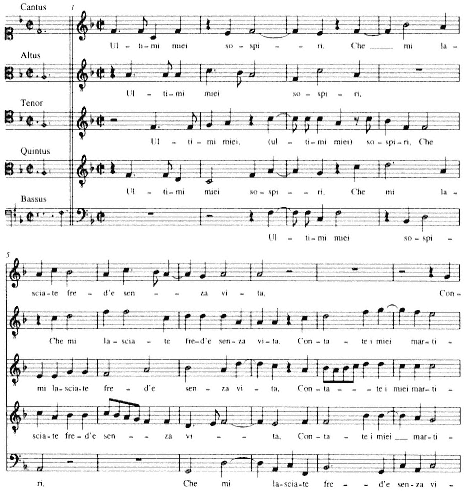
Ex. 42.
Parabosco, Ultimi miei sospiri (Lodovico Martelli), incl.; Madrigali a 5
(Venice, 1546), no. 6.
(continued on next page)
(continued from previous page)
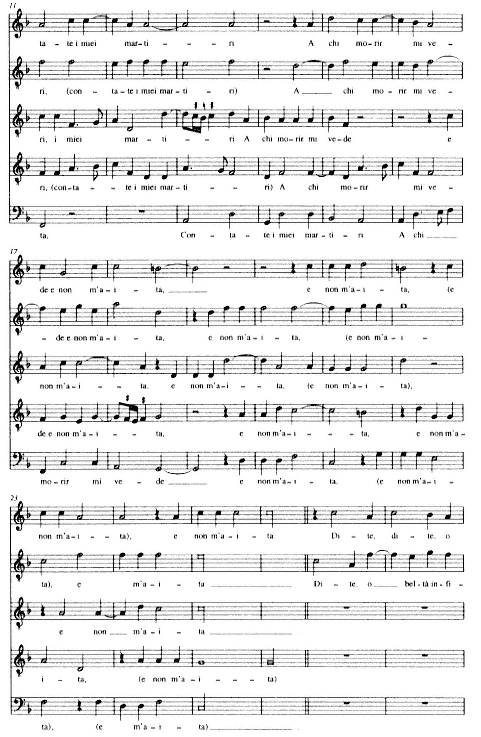
Ex. 4.2
(continued)
(continued on next page)
(continued from previous page)
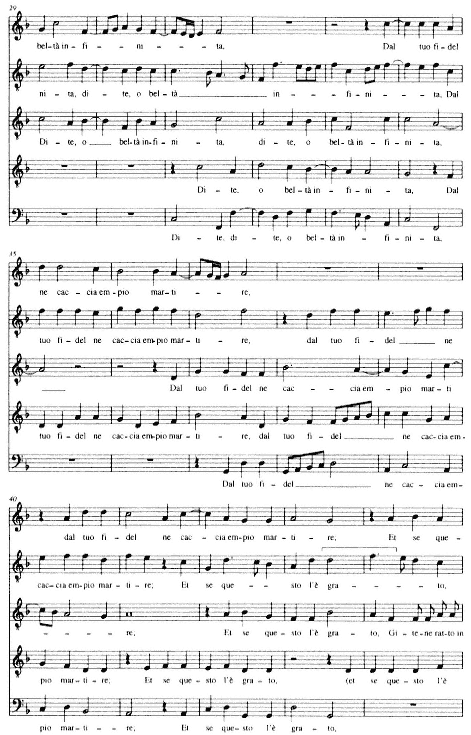
Ex. 4.2
(continued)
(continued on next page)
(continued from previous page)
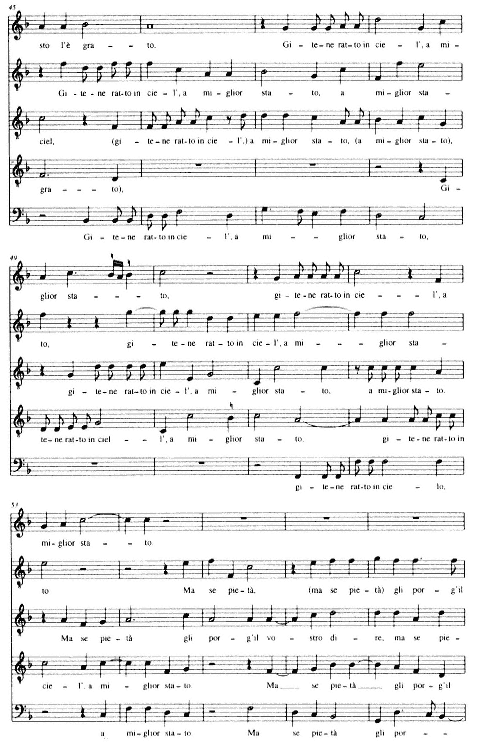
Ex. 4.2
(continued)
(continued on next page)
(continued from previous page)

Ex. 4.2
(continued)
Petrarchan sonnets Aspro cor and Solo e pensoso second mode. Most strikingly, all of the settings in the deuterus (Phrygian) category come from the "in morte" portion of Petrarch's Canzoniere — even the first four lines of the adapted Anima bella.
All of this jibes well with other knowledge of Parabosco. His debt to Rore's modally ordered Primo libro is clear at least in the case of Cantai mentre ch'io arsi and his book was dedicated to Rore's early patron Ruberto Strozzi. If modal issues occupied a place in the dialogues of Venetian salons, Parabosco would have been at the center of them, for he was as close to academic life there as any composer in the city.